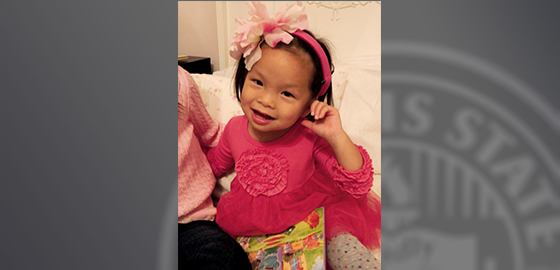Livi Prudent is one lucky child. She says so with every new sound she hears and makes.
Livi was born deaf and received the first of two bilateral cochlear implants when she was 28 months old and the second shortly thereafter. Now, less than a year later, the toddler is hearing speech sounds and saying whole words aloud.
Livi’s mother, Angi Martin-Prudent ’12, is a licensed audiologist and speech pathologist who received advanced training in the deaf and hard of hearing listening and spoken language professional graduate certificate program at Illinois State University.
At the time Martin-Prudent learned of the program, she and her husband were already considering adopting a child with hearing loss. Several months into the program they received word that Livi would be joining their family.
According to the National Institute on Deafness and Other Communication Disorders, nearly 188,000 individuals worldwide are fitted with a cochlear implant. The Food and Drug Administration approved the first implant for use in 1984 in adults age 18 and older, and in 1989 the age of implant candidates was lowered to children over the age of 2. In 2000, the device was approved for infants older than 12 months old.
“We know that there is a critical age in which children develop language—the more access to sound and communication the infant has, the easier it is to develop age-appropriate speech and language skills,” Special Education Professor Maribeth Lartz said.
“Now more than ever, I believe family is the key to achieving maximum potential,” Martin-Prudent said. “Parents are a child’s first teacher. While we work hard in our house to help Livi learn to listen and talk, she certainly deserves all the credit.”
Habilitation for prelingual children who receive cochlear implants is a highly specialized, family-based treatment program. Developing listening skills and spoken language is centered on family life and the interactions between the child and parents, siblings, and other caregivers.
Unfortunately, there are not enough providers trained to use these techniques.
“Many areas of Illinois have families waiting for early intervention services because there are no providers in their area,” Lartz said.
Lartz and project coordinator Tracy Meehan received the second of two $1 million grants from the U.S. Department of Education to provide advanced preparation to educators in Chicago and rural areas of Central and Southern Illinois who serve infants and toddlers with hearing loss.
Meehan said that while the work in the Chicago area continues, “the addition of the second grant allows us to offer the program to geographic areas of the state that are underserved or not served at all.”
Over the project’s lifetime, 44 participants will earn a graduate certificate and an early intervention credential from the state. They will complete a five-course program and supervised home- and clinic-based practice. Classes will be held at Illinois State University and in Chicago, and they will be connected through live videoconferencing with instructors at both sites.
In the second through fourth years, several graduates will be selected to receive an additional 12-month professional practicum and intensive fieldwork experiences in both home- and clinic-based settings. The mentees will also earn advanced certification from the AG Bell Academy and will serve as mentors for other early intervention providers in the deaf and hard of hearing listening and spoken language certificate program.
More information is available on the Special Education Department’s website.
How cochlear implants work
Data indicate that approximately one in 1,000 children are born deaf. With laws requiring universal hearing screening of newborns, they are being diagnosed earlier than ever. And, because of improving technology, many are receiving cochlear implants by the time they turn one.
A cochlear implant is a device that is used in young children, less commonly in older children and adults, with sensorineural hearing loss originating in the cochlea, or inner ear. According to the National Institutes of Health, there are 41,000 adults and nearly 26,000 children in the U.S. who communicate with the assistance of a cochlear implant.
The cochlear implant bypasses the damaged inner ear and provides direct stimulation to the auditory nerves, which carry electrical signals to the brain. One part of the device is implanted in the mastoid bone behind the ear and the second part is worn on the outside of the ear.
Typically, young children with profound hearing loss receive the implant between the ages of 12 and 18 months and require intensive habilitation to learn to hear and speak.


One thought on “As luck would have it”